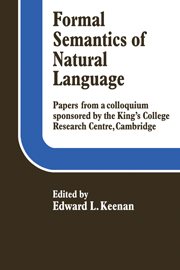Book contents
- Frontmatter
- Contents
- Notes on the contributors
- Acknowledgements
- Introduction
- I QUANTIFICATION IN NATURAL LANGUAGE
- II REFERENCE AND CROSS REFERENCE
- III INTENSIONAL LOGIC AND SYNTACTIC THEORY
- IV QUESTIONING MODEL THEORETIC SEMANTICS
- V PRAGMATICS AND SENTENCES IN CONTEXT
- VI SEMANTICS AND SURFACE SYNTAX
- Arguments for assigning tense meanings after certain syntactic transformations apply
- Towards a formal treatment of the phenomenon of aspect
- On the relations between syntax and semantics
- Logical expressive power and syntactic variation in natural language
Logical expressive power and syntactic variation in natural language
Published online by Cambridge University Press: 05 November 2011
- Frontmatter
- Contents
- Notes on the contributors
- Acknowledgements
- Introduction
- I QUANTIFICATION IN NATURAL LANGUAGE
- II REFERENCE AND CROSS REFERENCE
- III INTENSIONAL LOGIC AND SYNTACTIC THEORY
- IV QUESTIONING MODEL THEORETIC SEMANTICS
- V PRAGMATICS AND SENTENCES IN CONTEXT
- VI SEMANTICS AND SURFACE SYNTAX
- Arguments for assigning tense meanings after certain syntactic transformations apply
- Towards a formal treatment of the phenomenon of aspect
- On the relations between syntax and semantics
- Logical expressive power and syntactic variation in natural language
Summary
I will argue here that the task of formally defining logical structures (LS) for natural languages (NL) has a linguistic interest beyond the immediate one inherent in representing logical notions like entailment, presupposition, true answer to, etc. The reason is that LS can be used as a basis for describing, and in some cases explaining, certain kinds of syntactic variation across NL. Below we consider three types of comparison between LS and the surface structures (SS) which can be used to express them in different NL.
In the first comparison we will demonstrate that NL differ significantly in their capacity to form restrictive relative clauses. We explain this variation in terms of the Principle of Conservation of Logical Structure (Keenan (1972b)).
In the second comparison we show that NL differ in their capacity to stipulate the co-reference of NP positions, but we provide no explanation for this variation.
And in the third comparison we show that the expression of indirect questions (indQ) varies in restricted ways across NL and propose a Principle of Logical Variants which explains this on the basis of the LS we propose for indQ.
Type 1 comparison
Here we compare LS with the SS which can be used to express them in various NL. Obviously if a LS can be naturally expressed in some NL but not others then the former are logically more expressive in that respect than the latter.
- Type
- Chapter
- Information
- Formal Semantics of Natural Language , pp. 406 - 421Publisher: Cambridge University PressPrint publication year: 1975
- 5
- Cited by



